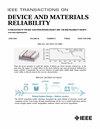An Improved Steep-Slope Triple Metal Gate-Dual Dielectric-GaAs-Pocket-HTFET With Interface Trap Charges Analysis
IF 2.3
3区 工程技术
Q2 ENGINEERING, ELECTRICAL & ELECTRONIC
IEEE Transactions on Device and Materials Reliability
Pub Date : 2025-08-04
DOI:10.1109/TDMR.2025.3595573
引用次数: 0
Abstract
This article presents a Triple Metal Gate-Dual Dielectric-GaAs Pocket-Heterojunction Tunnel Field Effect Transistor (TMG-DD-GaAs-pocket-HTFET) for low-power and high-speed applications. To enhance carrier confinement and suppress ambipolar current, the device integrates triple gates (M1, M2, and M3) with a dual-dielectric stack of HfO2/SiO2 on a single layer. Additionally, SiGe is utilized as the source material to improve tunneling efficiency, while GaAs is employed as the pocket material to enhance carrier injection and overall device performance. The device’s characteristics are investigated using the Silvaco-TCAD simulator, focusing on its switching behavior and subthreshold performance. Further, the device’s immunity under interface trap charge (ITC) like positive (P-ITC), negative (N-ITC), and without interface trap charge (W-ITC) conditions is investigated. At a gate and drain voltage of 0.5 V, the W-ITC configuration achieves a low threshold voltage (Vth) of 0.19 V, an ultra-low subthreshold swing (SS) of 2.53 mV/decade, and a high ION of一种改进型陡坡三重金属栅极-双介电介质- gaas -口袋- htfet及界面陷阱电荷分析
本文介绍了一种用于低功耗和高速应用的三金属门-双介质- gaas口袋异质结隧道场效应晶体管(tmg - dd - gaas口袋- htfet)。为了增强载流子约束和抑制双极电流,该器件在单层上集成了三栅极(M1, M2和M3)和HfO2/SiO2双介电层。另外,利用SiGe作为源材料提高隧道效率,利用GaAs作为口袋材料提高载流子注入和器件整体性能。利用Silvaco-TCAD模拟器研究了该器件的特性,重点研究了其开关行为和亚阈值性能。此外,还研究了该器件在正电荷(P-ITC)、负电荷(N-ITC)和无界面陷阱电荷(W-ITC)等界面陷阱电荷(ITC)条件下的抗扰度。在0.5 V的栅极和漏极电压下,W-ITC结构实现了0.19 V的低阈值电压(Vth), 2.53 mV/decade的超低亚阈值摆幅(SS)和5.83\ × 10{^{\text {-5}}}$ a的高离子,以及1.42\ × 10{^{{12}}}$的异常离子/IOFF比。结果表明,器件的性能不受正负界面陷阱电荷存在的影响。这些发现确保了所提出的TMG-DD-GaAs-pocket-HTFET是低功耗,高速应用的一个非常有前途的选择,具有出色的可扩展性和增强的性能。计算了跨导$(g_{m})$、栅极电容$(C_{gd}$、C_{gs}$)、截止频率$(f_{T})$、跨导频率积(TFP)和增益带宽积(GBP)等关键模拟/射频参数。此外,在W-ITC条件下进行了深入分析,以评估不同栅极工作功能,栅极长度和口袋材料对器件性能的影响。
本文章由计算机程序翻译,如有差异,请以英文原文为准。
求助全文
约1分钟内获得全文
求助全文
来源期刊

IEEE Transactions on Device and Materials Reliability
工程技术-工程:电子与电气
CiteScore
4.80
自引率
5.00%
发文量
71
审稿时长
6-12 weeks
期刊介绍:
The scope of the publication includes, but is not limited to Reliability of: Devices, Materials, Processes, Interfaces, Integrated Microsystems (including MEMS & Sensors), Transistors, Technology (CMOS, BiCMOS, etc.), Integrated Circuits (IC, SSI, MSI, LSI, ULSI, ELSI, etc.), Thin Film Transistor Applications. The measurement and understanding of the reliability of such entities at each phase, from the concept stage through research and development and into manufacturing scale-up, provides the overall database on the reliability of the devices, materials, processes, package and other necessities for the successful introduction of a product to market. This reliability database is the foundation for a quality product, which meets customer expectation. A product so developed has high reliability. High quality will be achieved because product weaknesses will have been found (root cause analysis) and designed out of the final product. This process of ever increasing reliability and quality will result in a superior product. In the end, reliability and quality are not one thing; but in a sense everything, which can be or has to be done to guarantee that the product successfully performs in the field under customer conditions. Our goal is to capture these advances. An additional objective is to focus cross fertilized communication in the state of the art of reliability of electronic materials and devices and provide fundamental understanding of basic phenomena that affect reliability. In addition, the publication is a forum for interdisciplinary studies on reliability. An overall goal is to provide leading edge/state of the art information, which is critically relevant to the creation of reliable products.
 求助内容:
求助内容: 应助结果提醒方式:
应助结果提醒方式:


